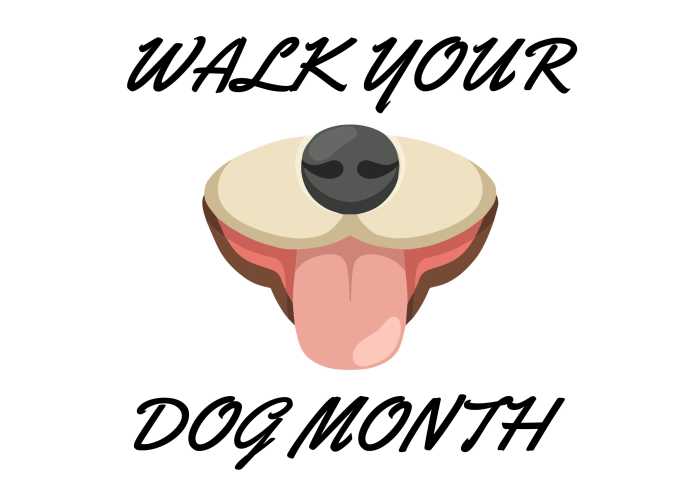
petGuard - Walk Your Dog Month
Posted on 1 January, 2024

Picture Source: Pikwizard
Written by and for petGuard
When is walk your dog month?
What better way to kickstart your new year than by walking the dog? Walk your dog month starts in the new year and lasts for the whole of January! So, put the snacks down, get off the sofa and get that dog walked!
Walk your dog month aims to get both pooch and owner enjoying the great outdoors. A brisk walk in the fresh air can be a great way to clear your head and to work off any indulgencies over the festive period – and your dog will love you for it.
Training your dog to walk on a lead
If you have trouble getting your dog to walk nicely on a lead, then don’t worry, you aren’t the only one! Here are a few tips to help.
- Start training in a safe place: It’s easier for your dog to learn good behaviours in a quiet place where they won’t get distracted.
- Praise and reward them: When your dog is by your side, you should reward them. Keep plenty of treats or a toy at hand.
- Lead the way: Make sure that it’s you who’s taking charge. Change direction every so often to make sure that your dog keeps their focus on you.
- Be consistent: Consistency is key with dogs. It might feel like hard work at the start, but if you stick with it, the reward will be well worth the effort.
How often should you walk your dog?
Walks are essential for your dog. As a rule of thumb, your dog should be walked at least three times every day.
Keep in mind that some dog breeds are less active than others and may not need to be walked quite as much (think Great Danes, Bulldogs or Mastiffs). All dogs though, need some form of daily walk in their routine and it needs to be more than just a toilet break. Regular walks give your dog the chance to explore and keeps them mentally healthy too. A dog’s metal health is important and walks keep them stimulated, so they won’t then become destructive or anxious when left alone. Of course, much like us, regular exercise also keeps your dog physically healthy too and helps ward off obesity.
In 2021, the Royal Veterinary College (RVC) revealed that over 7% of the UK’s dogs were considered obese. While a few pounds may not too bad for your pooch, pet obesity is a serious problem. Much like in humans, pet obesity can cause arthritis, heart disease, diabetes and certain types of cancer.
How long should you walk your dog for?
Border Collies are one of the most active and smartest dog breeds.
In general, most dogs should be able to walk for 20-30 minutes at a time. This does depend on the age of your dog and which breed they are, however.
High-energy dog breeds may need as much as two hours when they’re out for walkies. These breeds include:
- Labradors
- Golden Retrievers
- Huskies
- Border Collies
- Terriers
Remember that physical activity is good for you and good for your dog. Walks give your dog the chance to play, explore and stretch their legs – but it’s good to stretch yours too!
The NHS recommends that adults between the ages of 19 – 64 should do at least 150 minutes of moderate intensity activity a week. So, even if you’re only walking your dog for 30 minutes at a time, this should be easily achievable.
Every dog is different though, and there’s by no means a magic formula for how often your dog needs to spend outside on their walk. Older dogs naturally won’t be able to run around for as long as they did when they were pups and some dogs just won’t take to being outside for too long. If your dog seems to be uncomfortable when they’re out walking, then it may be time to cut down on their outdoors time.
Can you walk your dog too much?
You might be surprised if your dog is the kind to endlessly demand to play fetch, but you can walk your dog too much.
Much like humans, dogs increase their fitness levels over time. Any sudden changes in how long they spend exercising can leave them over-worked and tired out. Say for instance that your dog is only used to a 20-minute walk in the morning, but you have a busy afternoon planned. If you try and squeeze in a lot of their daily exercise time in one walk, then this may actually be harmful to your pooch.
Here are some signs that your dog may have bitten off more than they can chew during their walk:
- Stiffness and sore muscles: If your dog is struggling to jump or get up the stairs after a walk, then this may be a sign that their muscles are stiff or sore. They’ll need to tone down their time exercising in the coming days as they recover.
- Tiredness: It’s perfectly normal for a dog to have a little snooze after they come home, but if they stay asleep for a long time, then this may be a sign that they’re exhausted from their walk.
- Sluggishness: If your dog is struggling to keep up and is lagging behind on their walk, then they may be very tired. If your dog is usually way out in front, then this becomes more of a problem.
Keep the temperature and the weather conditions in mind too before you set off for a walk. In the summer, if the temperature is hotter than 20°C than be careful about taking your dog out. Heat stroke is a very serious problem for dogs and the risks are greatly increased if your dog has underlying conditions.
Where are some of the best dog walks in the UK?
he Lake District is a perfect place to take your dog for a long walk.
Most of all though, dog walking is about fun! We’re blessed in the UK to be able to have some of the very best scenic spots right on our doorstep. At petGuard, we’ve put together some of our favourite dog walks:
- Derwentwater, Lake District
- Hadrian’s Wall, Northumberland
- Rhosili Bay, South Wales
- Yorkshire Dales, Yorkshire
- Lizard Point, Cornwall
To read the original article written by and for petGuard, please visit: www.petguard.co.uk/walk-your-dog-month
Tags:



